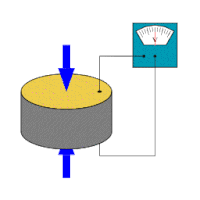
Photo from wikipedia
Developing piezoelectric ceramics with high piezoelectric properties and broad temperature usage ranges via low-temperature sintering is one of decisive importance for flourishing developments for emerging electromechanical applications. However, these properties… Click to show full abstract
Developing piezoelectric ceramics with high piezoelectric properties and broad temperature usage ranges via low-temperature sintering is one of decisive importance for flourishing developments for emerging electromechanical applications. However, these properties are usually mutually exclusive, such as low-temperature sintering and high piezoelectricity as well as high piezoelectricity and temperature stability. Here, we report high piezoelectricity (i.e., piezoelectric constant d33 ≈ 744 pC/N, electromechanical coupling factor kp ≈ 75%, and Curie temperature TC ≈ 201 °C) and superior temperature stability (d33 varies less than 10% within 25-160 °C) in Pb0.905Ba0.095(Zr0.54Ti0.46)O3 + 1 mol % Nb2O5 + 1 wt % Bi2O3 + x wt % CdCO3 (PBZTNB-xCd) ceramics that are fabricated at a sintering temperature of as low as 960 °C, superior to those of other reported random and textured ceramics. Good piezoelectricity is attributed to the remaining rhombohedral-tetragonal (R-T) phase coexistence and the high ceramic density. Excellent temperature stability is related to the stable crystal structure and domain structure. These properties confer to the produced materials attractive characteristics for further consideration in several advanced applications, especially for piezoelectric transducer applications requiring constant structures over a broad temperature range.
Journal Title: ACS applied materials & interfaces
Year Published: 2022
Link to full text (if available)
Share on Social Media: Sign Up to like & get
recommendations!